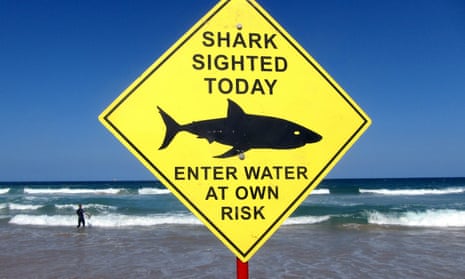Shark-tracking drones are being deployed to protect Australia’s beachgoers following a series of attacks on surfers. Trials will begin next week as part of a strategy by the New South Wales (NSW) government, which will also see hi-tech drum lines installed to allow sharks to be hooked, tagged and released further out to sea.
The drones will feed images with GPS coordinates back to operators looking for sharks, with the first field tests being conducted off Coffs Harbour, about 285 miles (380km) south of Brisbane.
The first of the drum lines will be installed at Ballina, where a 20-year-old local surfer, Sam Morgan, was bitten by a bull shark earlier this month, and where a surfer from Japan, Tadashi Nakahara, 41, was killed by a shark in February.
The baited drum lines, previously used in the shark-infested waters of Réunion island, east of Madagascar, instantly alert monitors when a shark has been hooked so it can be swiftly released and moved, unlike traditional lines that are checked intermittently.
Helicopter surveillance is being increased as the main summer holiday season gets under way and politicians wrestle with how to balance protecting swimmers and surfers while acting in the best interests of the sharks.
The trials are part of a $16m (£7.7m) five-year strategy to combat shark attacks that will include real-time tracking of tagged sharks using 4G technology, with 20 listening stations being built along the NSW coast at known shark attack locations.

An app, called SharkSmart, will allow members of the public to receive shark alerts in near real time on mobile phones and tablets. Eco-friendly barrier nets will also be installed.
Niall Blair, the NSW minister for primary industries, said there was no easy way to reduce shark attacks, but the government’s approach was to use available science and emerging technologies. In total there have been 14 shark-related incidents, one fatal, on the NSW north coast this year.
“These are the first of several trials that will get under way across the state’s beaches this summer as we take an integrated approach to working out a long-term solution,” Blair said in a statement.
He told the Australian Broadcasting Corporation (ABC) the hi-tech drum lines were more humane than the traditional lines that have been used in Queensland and Western Australia.
“They’re like a baited hook that has technology connected to it so when the bait is taken, a message is sent to our vessels and they’ll attend those lines immediately.
“They will then tag and release the sharks that are caught on those. So they’re very different to the traditional drum lines which could have sharks sitting on them for days before they’re checked.
“We think this is a bit of a gamechanger for Australia.” However, he agreed there was nothing to stop a shark returning to the area.
The NSW premier, Mike Baird, said the approach was based on science, not emotion. “The experts have told us these are the technologies that have the potential to lead to a long-term solution to keep our beaches safe and minimise the impact on marine life.”
Shark-spotting helicopters will fly for at least three hours a day in certain areas during the peak holiday season between 1 December and 26 January.
Environmental groups have expressed concerns over the drum lines, saying they put dolphins, turtles and non-dangerous sharks at increased risk of injury or death.
“Putting the drum lines into a marine park is of concern because there are a large number of dolphins, and critically endangered grey nurse sharks, and turtles, and other things that are likely to become entangled,” Sharnie Connell, founder of the campaign group No NSW Shark Cull, told ABC News.
There have been calls for independent monitoring to ensure animals or marine life trapped on the drum lines are released within two hours. The Ballina MP and the NSW Greens spokeswoman for the marine environment, Tamara Smith, has said she will be seeking to join monitoring crews throughout the trial period.
A recent shark summit in Sydney, attended by dozens of international scientists, examined various deterrent measures: physical and visual barriers, sonar technologies, and satellite and acoustic technology to allow tagging and real-time tracking of sharks.
One identified as suitable for trial is the Clever Buoy system, described as a “smart ocean buoy that detects sharks and alerts lifeguards on the beach”, and which uses sonar to distinguish the type of shark.
The summit heard that netting and culling of sharks would be out of step with public opinion. Christopher Neff, a lecturer in public policy at the University of Sydney, told ABC at the time that research showed more than 80% of people in the Ballina and Byron coastal areas were opposed to killing sharks.
“The data that I’ve seen for the last three years, whether it’s from Western Australia, whether it’s from Sydney, whether it’s in Cape Town, or whether it’s in Ballina, have all said: ‘Don’t kill the sharks.’ The only people who are talking about killing the sharks usually is the political class,” he told the broadcaster.
